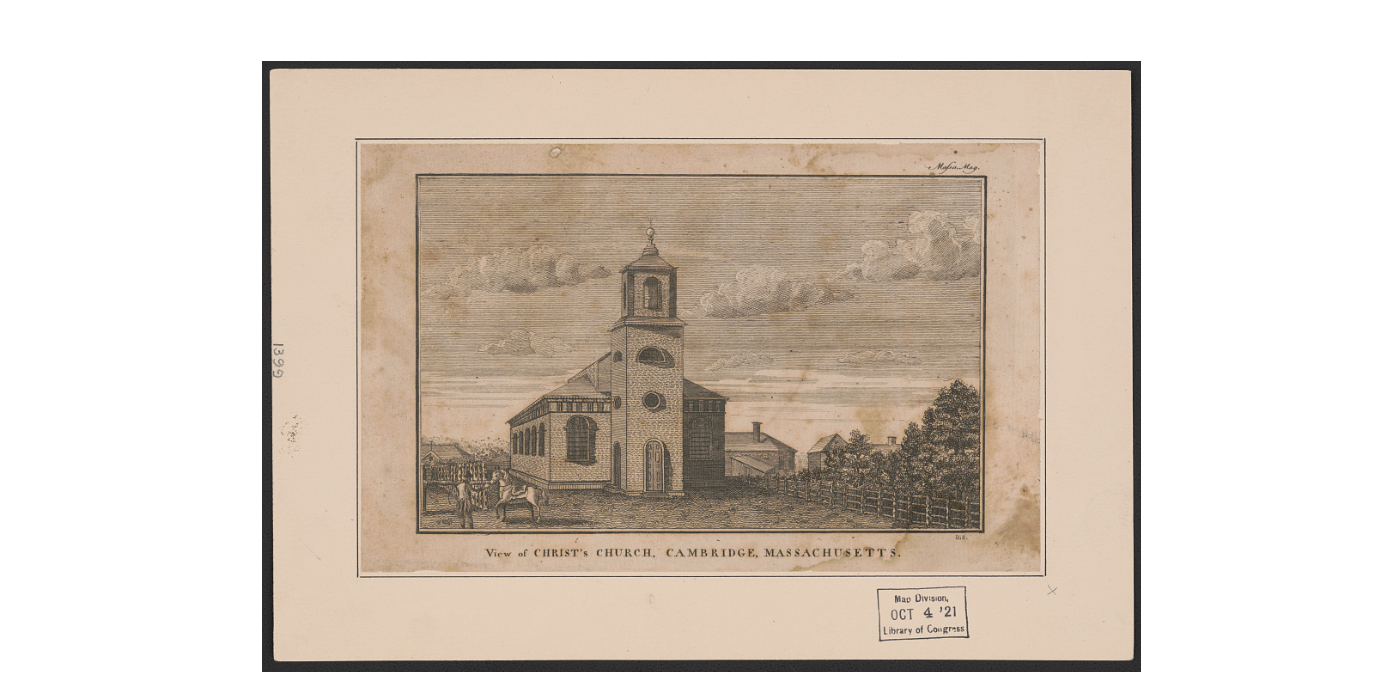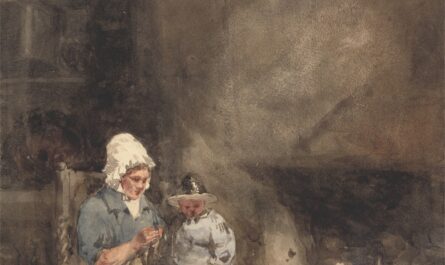Image above: View of Christ’s Church, Cambridge, Massachusetts / Hill. Hill, Samuel (approximately 1766-1804)Engraver. 1792, July.
How did the legalistic culture of the Puritans of the 1620s become the permissive, democratic culture of the 1820s, characterized by the Unitarians?
Fascinatingly, both the Puritans and Unitarians can trace their doctrinal roots back to Congregationalism during the Protestant Reformation. The Congregationalists rejected the centralized authority of the Anglican Church, and insisted that each congregation should have authority over their own affairs. In 1740, the Congregational Church comprised one-third of all American churches, and by the time of the nation’s founding, they made up twenty-one percent. Over the next century, Congregational churches would undergo many shifts and splits, emerging in the 19th century under various denominations.
The Puritans
The Puritans were Protestant Christians in England and Scotland who rejected the centralized authority and structure of the Church of England, which mirrored the Catholic Church. Between 1620 and 1640, these believers fled Europe and traveled to north America, determined to establish a new civilization, “a city on a hill.” The term “puritan” was disparaging and those with Puritan beliefs didn’t refer to themselves as Puritans. There is also no universally accepted definition of “puritan.” The Puritan culture dictated early American law, work ethic, religion, as well as past times and social behaviors.
Upon arriving in the New World, the Puritans established the Massachusetts Bay Colony, which was as close to a theocracy as the New World has seen. Their laws were based explicitly on social norms and punishments in the Bible and they expected the government to enforce moral standards. They required full church membership to vote, and local taxes supported the church. Perhaps the greatest enduring influence the Puritans handed down to us has been their views on work and rest. These Christians took Paul’s edict in 2 Thessalonians 3 strictly literal, mandating work be done six days of the week, then cease in observance of the Sabbath and personal study of Scripture. Holidays were banned because they interfered with work. They also believed it was the responsibility of government to enforce morality and Christian observances. A quote from author Judith Shulevitz in The Sabbath World, who is quoting Puritan thinker Thomas Shepard’s Theses Sabbaticae, reveals just how seriously the Puritans regarded observing the Sabbath,
“Children, servants, strangers who are within our gates,” he wrote, in a direct echo of the Fourth Commandment, “are apt to profane the Sabbath; we are therefore to improve our power over them for God, in restraining them from sin, and in constraining them (as far as we can) to the holy observance of the rest of the Sabbath.”
Arguably, the most commonly known example of the Puritans’ laws and retribution was the ban on witchcraft, which culminated in the Salem Witch Trials of the 1620s. Local laws didn’t only forbid witchcraft, though. They extended to banning doctrinal disagreements and contended that personal revelation was not Biblical. Ultimately, the Puritans made it illegal to profess other doctrines which resulted in the executions of several Quakers. The hanging of the Boston Martyrs in 1659 and Mary Dyer in 1660 – executions carried out for the crime of being a Quaker in Massachusetts – marked the end of Puritan persecution, as King Charles II specifically forbade executions of Quakers from 1661.
The term “Puritan” calls to mind rigid rules forbidding drinking, dancing, or any sort of general good time in dutiful deference to work. While they certainly had rigid rules and interpretations, they weren’t opposed to all merriment. They were not teetotalers and did drink in moderation. They did, however, also believe the alehouses should be regulated to ensure no indecent behavior. They also considered it a sin for spouses not to perform their duties toward one another, and allowed for divorce for such neglect. One of their highest priorities, though, was education. We can see just how important study was to them by the fact they had established Harvard University within just six years of arriving in North America. They also built separate schools for their boys and girls to attend as children. It was critical everyone learn to read Scripture for themselves. One of the earliest laws they enacted was that every family must teach their children to read, so they could study the Bible for themselves. The Puritans’ reverence for personal study and reading of Scripture would continue to play a key role into the next century.
The Great Awakening
The Great Awakening (First, 1740-1755 and Second, 1790-1840) brought a new passion to American religion, encouraging believers with a new vigor to read and study their Bible for themselves at home. Christians were encouraged to become active and emotional participants in their faith, rather than passive. During this time, preachers maintained that assurance of salvation was a normative part of the Christian life, breaking with Puritan doctrine claiming such assurance was rare. Jonathan Edwards wrote several treatises on “Christian practice,” which focused on continual acting out of the Christian’s faith.
The Christian response to the Great Awakening shows the beginning of a sharp divide between conservative and liberal Christianity, still in place today. The Methodist Church was the largest church in the New World at the time, and the birthplace of the Great Awakening, after which it grew rapidly. The Methodist Church is named after their intention to follow the ‘methods’ of John Wesley in England. Methodism emphasizes educating youth and personal study of Scripture, and has always been active around social issues. The Methodist Church would become a major force for abolition up to and during the Civil War, working extensively with the Underground Railroad and establishing churches for freed slaves. The Methodist church was the largest denomination in the country by 1820, grew to over 4 million members in 1846, and continues to be one of the largest denominations in America today. The Library of Congress describes its growth like this, “The remarkable growth of the Methodists in the post-Revolutionary period has been attributed to a hierarchical organizational structure that permitted the maximum mobilization of resources. The “corporating genius” of the Methodists is depicted in this series of concentric circles.”
George Whitefield was the most famous preacher during the Great Awakening. His “Sinners in the Hands of an Angry God,” was the most famous sermon of this movement. He actually co-founded the Methodist Church with Charles and John Wesley, but ended up leaving Methodism shortly thereafter over doctrinal disagreements. Whitefield’s preaching was filled with appeals to emotion, and urged the private interpretation and practice of religion. He wanted Christians to have certainty of their salvation. For Whitefield, the focus of the Christian life shifted from a theological or doctrinal basis, to whether the person had an individual encounter with God. This movement emphasized personal experience over intellectual training. Whitefield himself was a divisive figure, even within the church. He was also barred from preaching in many churches, due to his emotional and rowdy speaking style. This prompted him to begin speaking outdoors, where crowds would gather. He eventually spoke to thousands at a time, his voice booming without the modern convenience of amplification.
The reaction to this disorder – “unqualified” preachers and speakers commandeering pulpits, full of emotion, causing commotion in the church and generally being informal in their preaching or services – dictated the course of American Christianity for the next century. The reaction split the American Church. Those who were suspicious or disapproving of the revivals were considered “Old Lights.” The “Old Lights” are still around today, mainly consisting of the United Church of Christ. Those in favor of the revival were called “New Light” believers, a reference to Jonathan Edwards’ description of the revivalists as having a “new light” shine on them. The more progressive New Light believers embraced adult baptism and decentralized authority (maintaining their Congregational roots), left their local churches, and sparked new denominations, like the Church of Jesus Christ of Latter-Day Saints (Mormons), or reinvigorated existing ones, including the Baptists and Presbyterians.
The Old and New Light divide seems to be the root of the American Christian culture splitting, turning away from more repressive, exclusive, and legalistic doctrine of Puritan Calvinist thought, to a more socially and ethically motivated church. The Enlightenment imparted values like rationalism and democracy, along with the desire to separate the church from civil government. One specific group of the “New Light” Christians enthusiastically embraced Enlightenment values and professed deism, creating another branch of Christianity.
The Unitarians
The major difference separating Unitarians from other Christian denominations is deism. In contrast to the Father-Son-Holy Spirit, Triune doctrine conservative Christians follow, the Unitarians maintain God is a single deity. They believe Jesus was not divine, but a prophet, and the ultimate representation and model of a human being. Unitarians call for the Bible to be read and interpreted through rational thought, denying Scripture is inerrant and cautioning it should not be taken literally. Their thinking is so liberal, many other denominations don’t consider them to actually be Christians. The denomination was first established in 1784, and was intently focused on ethics and social causes. In 1825, these “New Lights” established the American Unitarian Association. The Unitarian Church emphasize social reform and aim to bring the church in line with a more progressive society.
In the early 1800’s the prominent thought leader in the Unitarian church was a priest named William Ellery Channing. He fought against Calvinistic (Puritanical) orthodoxy in favor of private interpretation and judgment. In his “The Moral Argument Against Calvinism,” he sought to combat orthodoxy and introduce a milder form of Christianity. He emphasized Christians must apply reason to Scripture. He also maintained the church and minister are vital to keep congregation and society advancing and remind individuals of their ethical responsibilities. As Oxford’s Farhang Jahanpour notes, “[W]hile these ideas exhibited a complete departure from the traditional Trinitarian and especially Calvinistic dogma, the Unitarians did not regard themselves as any less Christian than others. In fact, they believed that in the same way that Christianity was a revolt against Jewish orthodoxy, and Protestantism a revolt against Papacy, so was Unitarianism a further revolt against the erroneous doctrines of some Protestant churches and contained the true spirit of Christ’s teachings.” Channing’s thoughts were clearly revolutionary, and gained acceptance.
Many scholars consider deism the “religion of the Enlightenment,” citing the many founding Fathers and intellectuals who professed to be deists, among them Thomas Jefferson and James Madison. The rise of the Unitarian church would also support that view. At the same time of the Great Awakening, the age of Enlightenment was coloring the educational, social, and governmental spheres. The Enlightenment ushered in rational, empirical thinking; prized reason over emotion; emphasized fraternity and cooperation; and saw the rise of the public sphere. Political writers Voltaire and Rousseau advocated for democratic government, while philosophers like Hume, Locke, and Descartes influenced readers on the value of rationalism. All of this elevated the importance of private study, while calling church doctrine and authority into question.
Also during this time, America was growing; the population more than quadrupled between 1790 and 1840 and the colonies were expanding westward. The old doctrine of Calvinist and Puritan religion no longer held excitement or promise, while the New Light of personal introspection, emotional experience, and private study proved more appealing to most Americans. The combination of these movements, heavy on literature, cooperation, and private study, ushered in a publishing boom and a leap in literacy rates. It also saw a decline in hierarchical doctrine, in favor of a personal and more emotional faith experience.
The Unitarians incorporated many of the Enlightenment teachings into their doctrine. They held that Scripture needed to be viewed with rational eyes and not be taken literally. Unitarians believe that since Scripture was written by humans inspired by the divine, the possibility exists for mistakes or inaccuracies. They also prioritize free will and individual judgment over doctrine. The Unitarians embraced the New Light teaching of personal revelation and combined that with an emphasis on social issues, following Enlightenment thought on fraternity and personal ethics.
Our Current Moment
Clearly, the Great Awakening had long-lasting consequences on American culture. After tracing Puritan and Unitarian thought through the 17th and 18th centuries, I wondered what such a drastic change in culture would mean today. How would such a change even occur? In my recent conversations on the topic, the suggestion of a “great splintering,” came up. The idea is, in contrast to the centralized Great Awakening, which was dependent on in-person gatherings and published reading material either in support or opposition, the internet presents decentralized cultural moments, a Great Splintering. The internet is simply too vast, and allows for an unlimited amount of potential interests, dogmas, or theories. There are dozens of “movements” happening online the average person would know nothing about. Just look at what trends on Twitter vs the weekly headlines. Instead of our moment coming down to a single nation-wide event to support or oppose, this Splintering will revolve around what happens online and goes largely unnoticed in the ‘real’ world. That is, until the online theories take hold in the physical world. We’ve recently seen this play out in the coverage of the QAnon conspiracy. What seems to be a huge ordeal online often fails to make an impression on the national stage. In the peculiar case* of QAnon, it was only after extensive reporting in The Atlantic, the New York Times, and other large readerships the cult began to appear in prime-time news coverage, illustrating the massive amount of internet coverage needed for something niche to crossover into the mainstream.
The internet represents a Great Splintering of ideas, norms, and movements, potentially signaling the end of wide-sweeping national cultural change.
One’s interpretation of the Great Awakening seems to be the key point of separation between the Puritanical or “Old Light” believers from the progressive Christian and Unitarian denominations. It is another instance of the classic debate between doctrine and rationalism. Today, our response to the internet represents a similar “Great Splintering” of interests, causes, and ideologies which don’t gain traction in the mainstream, but are popular amongst niche groups. What does this mean for the public sphere and mainstream American culture? It underscores the need for rational discourse, education, and intellectual humility – the very values the Enlightenment gave us nearly two hundred years ago – so we can ensure our society continues to progress in democracy, rational thinking, and innovative scientific breakthroughs.
*Footnote: The QAnon conspiracy is peculiar in that it overlaps with the larger defining moment of American Christianity. In the wake of the Trump administration, various scandals involving renowned leaders, and dispute over which social causes to support, this cult gained a following among those hurt by the Christian church.




